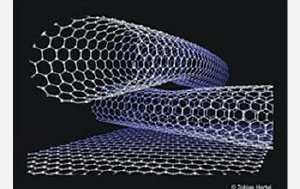Feb 10 2009
Carbon is the fourth most abundant element in the universe by weight, and without it, there would be no life on Earth. Depending on its crystal structure--how its atoms bond together--carbon can form several different substances, ranging from sooty coal to glittering diamonds to slippery-smooth graphite.
 Ball and stick model of two crossing (10, 10) carbon nanotubes on a graphite surface. Credit: Tobias Hertel, Institute for Physical Chemistry, University of Wurzburg
Ball and stick model of two crossing (10, 10) carbon nanotubes on a graphite surface. Credit: Tobias Hertel, Institute for Physical Chemistry, University of Wurzburg
Slice a chunk of graphite into a flat, single-atom thick sheet, and you get another form of carbon: graphene. Take a sheet of graphene and roll it up like a newspaper, and you get a carbon nanotube (CNT).
CNTs are nanoscale molecules made up of large numbers of carbon atoms, each bonded to three other atoms in a hexagonal (six-sided) pattern, resembling a roll of chicken wire. The pattern can be aligned with the tube's central axis, or it can be twisted. Although a CNT may reach a few centimeters in length, the entire tube is only a few nanometers across, or about 100,000 times thinner than a human hair. At this size, it behaves as if it were one-dimensional.
Promising Properties
So much for the what. But why are CNTs making headlines in fields as diverse as aerospace, opto-electronics and bio-medicine? In a word, properties. Because of their superior structural, chemical, optical and electrical properties, carbon nanotubes are among the most promising candidates for use in tomorrow's ever-shrinking technology.
Mechanically, CNTs are five to 50 times stronger than steel, even though they are incredibly small and light. They also conduct heat extremely well. But it's their optical and electrical characteristics that have many scientists and engineers proposing applications ranging from flexible electronics and photovoltaics, to sensing and fluorescent markers in life sciences.
"CNTs have potential for complementing or replacing many current technologies," said Oscar O. Bernal, NSF program director for condensed matter physics. "For instance, they could one day become the main components in lighting devices and consumer electronics. They could represent savings in energy usage and would have the advantage of being very small, allowing miniaturization beyond current limits."
According to Bernal, understanding how particles move through CNTs is one of the necessary steps in the process of developing new applications.
Tobias Hertel, chair for physical chemistry at the University of Würzburg, is developing an experimental tool to study the unique light-emitting properties of CNTs. Hertel began the work while an associate professor at the department of physics and astronomy at the Vanderbilt Institute of Nanoscale Science and Engineering (VINSE), and is supported by a continuing grant from NSF.
Hertel, along with other scientists from Italy and Germany, recently published an article in Nature Physics, entitled, "Size and mobility of excitons in (6, 5) carbon nanotubes," which looks at how photons travel through a semiconductor type of CNT.
"CNTs become semiconducting or metallic depending on their specific diameter and twist," said Hertel. "In this case, we chose a chiral type nanotube, with chains of atoms curled like a corkscrew."
Chiral CNTs can be visualized as twisting a piece of chicken wire so that one hexagon overlaps another on both a different row AND a different column of the pattern. The amount and direction of twist in a CNT can be coded as (n, m), where n is the number of rows and m is the number of columns from the initial atom to the overlapping atom.
Measuring Excitons
The scientists measured the size of the excitons by studying how many would fit into a nanotube. "Say we had a one-gallon sized container filled with marbles," Hertel said. "If we wanted to know how big each marble is, we could simply count the number of marbles in the container." So, for example, if there were 128 marbles, each one would take about as much space as one fluid ounce, since there are 128 fluid ounces in a gallon.
"We found the excitons to be of similar size as the width of the nanotubes, which means that they can either travel forward or backwards in the tubes but not sideways, similar to the big ship in the canal," Hertel said. "Theory had predicted only slightly smaller exciton size than what we observed, but it was nevertheless surprising to find they were so large. We interpret this as a manifestation of the truly one-dimensional character of excitons in CNTs."
In addition to size, the scientists studied the mobility of the excitons. "Mobility is crucial because it allows us to better understand what can happen to an exciton over its lifetime," Hertel explained. "If excitons have a large mobility, they are likely to travel all the way to the ends of CNTs--where some 'bad' things (like non-radiative decay) may happen to them. But we found that the mobility is actually rather small and that excitons don't travel all that far during their lifetime."
Theoretical predictions of exciton behavior in such systems are still rather difficult and need to be corroborated by experiments, Hertel believes.
Questions remain for the scientists. "Exploring the effect of the environment on exciton size and mobility is the next step," said Hertel. "Can we tailor the environment to alter the exciton size and mobility in a desired way?"